Introduction. A basis of urgency
The problem of diagnostics in the field of public health services and the control of functional activity of various bodies of the person is the important problem. In this connection there is a necessity for creation of devices of diagnostics by means of which it would be possible to establish a degree of working capacity of lungs with high reliability.
For today of devices it is not enough for the operative control of the maintenance of oxygen over blood. In most cases the control is carried out visually, that does not give full representation about work of lungs. There is a problem of the control of saturation of blood oxygen which parameters is saturation and parciation pressure which at normal gas exchange should be within the limits of 95-98 % and 90-115 mm h.p. accordingly. Therefore development of devices of the operative control of the maintenance of oxygen in blood is an actual problem.
The purpose and problems of work
The purpose of work: to develop the device intended for definition containing of oxygen in blood of the person. The knowledge of this parameter is necessary in an expert of surgery, traumatology, and also in some other areas of medicine.
Problems of work is the substantiation of a photometric method, bases on thefixation of the reflected stream, development on the block diagram, elements of a design of the device, and also increase of accuracy of measurement and speed of the device.
At present manufacture of a similar sort of devices in Ukraine, as it is known for us, is not carried out. Existing western analogues have very high cost.
Tne task of my work consists in development a device of the operative control having cost on the order below foreign analogues and the means - above of foreign analogues.
Prospective scientific novelty
The idea of my work consists in maintenance of the operative control of the maintenance of oxygen in arterial blood during surgical intervention. Prospective scientific novelty of work consists what this parameter can be received by a two-frequency photometric method, at definition saturation is take into account such influencing factors as change parciation pressure of oxygen in blood and a body temperature of the person, remote optical probe possessing small dimensions and joining in blood system of the person is developed.
Existing methods and development
Existing methods of the analysis is laboratory, they demand s concerning greater expenses of time, nearly tens minutes, that in emergencies is inadmissible and should be reduced. Existing laboratory methods are directed on definition of optical density. Optical density of blood is very high and must be thin layer, blood is added with plasma, that is belowed accuracy of definition of oxygen laboratory methods.
Definition of the maintenance of oxygen in blood on mercury device Van-Slajka
Saturation of hemoglobin oxygen defined on mercury device Van-Slajka, and research proceeded 2-2,5 hours as it was necessary to define all over again the maintenance of oxygen in blood, then to sate it up to 100 % of saturation in сатураторе and to define oxygen capacity and only then to calculate percent оксигемоглобина HbO2. Lacks of this method are obvious: duration of analyse and use of mercury.
Gasohromatographic method of definition of oxygen in blood
Gasohromatographic the method of analysis O2 in blood has a number of advantages: the insignificant volume of blood is necessary for definition of 0,1-0,2 ml, some minutes are spent for carrying out of the analysis of all. In hromatographs, specially intended for the analysis of the dissolved and connected gases of blood, operation of chemical processing of test of blood spend in a separate reactor and upon termination of reaction the allocated mix of gases blow a stream of gas-carrier in прибор.
Relative accuracy hromatographical in blood makes definitions of gases ±3 %. The threshold for A2 and N2 is equal approximately 0,5 about. %, for О2 и N2 2 %. Duration of the analysis nearby 10 minutes.
Gasohromatographic method of analysis O2 in blood has a number of advantages, in particular, accuracy of measurement, but gasohromatograph represents installation of laboratory type of greater dimensions that assumes its local application only in laboratories and unfitness for the express train-analysis in emergencies, and also use of reactants represents inconveniences and brings an additional error in result of measurement.
The means realizing a potentialmetrical method
The means realizing potentionmetrical a method of definition of the maintenance of oxygen in blood, are presented by oxigemometer. In comparison with previous a method they enable quickly and directly to receive size of saturation of blood oxygen in percentage and allow to spend continuous supervision over patients.
The device of oxigemometer. The photo cell presented in figure 1, is the metal plate covered by a photosensitive material. Under influence of rays of light from a photosensitive material "are beaten out" electrons which form electronic cloud, therefore a silicon plate, being charged positively, gets potential. If to connect silicon and copper a plate (last has zero potential) to a galvanometer the deviation of its arrow will register a potential difference.
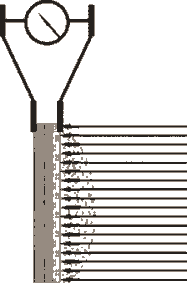
Figure 1 – Principle of realization a potentialmetrical method
The potential difference will be the more, than it is more intensity of the light stream directed on a photo cell.
Blood is density enough substance, and the principle of action is based on measurement of factor an absorbtion that indications depend on thickness of a layer, that brings an additional error and increases process duration of measurement.
Technique of pulse oxymetry
The technique of pulse oxymetry is based on used principles photopletizmography, allowing to allocate an arterial component of absorption of light for definition an oxygen on arterial blood. Measurement of this component enables to use spectrophotometry for nonivasive monitoring oxygen saturation in arterial blood. (Figure 2).
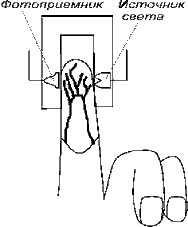
Figure 2 – The gauge photopletizmogram at research of a blood-groove in a finger of a hand.
According to law B-L, size of absorption of light is proporcional to thickness of a layer of absorbing substance. Narrowing and expansion of a vessel under action an arterial pulsation of a blood-groove cause respective alteration of amplitude of a signal.
Photopletizmogram received after strengthening and processings of a signal of a photodetector (figure 3) characterizes a condition of a blood-groove in the location of the gauge.
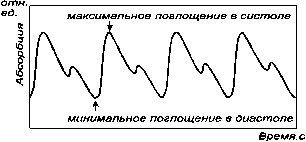
Figure 3 – Photopletizmogram peripheral pulse
Two-beam spectrophotometric is used for definition saturation. Measurement of absorption of light is made during the moments sistolation emission, that is during the moments a maximum amplitudes of a signal of the gauge for two lengths of waves of radiation. For this purpose in the gauge to use two sources of radiation with various spectral characteristics.
Advantages of such devices is their mobility and an opportunity of carrying out the express train-analyses. But it is impossibility to synchronize the moment of a maximum of a wave and radiation of a source. And also because of persons factor and phase delay will be observed. These factors lead mistakes on measurements.
Photometric oxymetry
The spectrophotometrical technique is often use in research blood saturation. It consists in measurement of absorption of light which has been last through test of blood in various spectral ranges is widely used.
Quantitative bloodspectrophotometry is based on use of Beer-Lambert (B-L) law for solutions which connects intensity falling (Ifal) and intensity passing (Ipas) through investigated test of light (figure 4): :
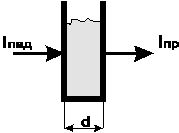 Ipas = Ifal ехр ( – А), Ipas = Ifal ехр ( – А),
Figure 4 – To Вееr-Lambert law.
where А = k [С] d - it is size of absorption (absorption) ;
Here k - factor molar exctintion, constant for everyone substain and lengths of a wave of falling light;
[C] - Concentration of substance absorbing light;
d - Thickness of a layer of absorbing substance.
Research of optical properties of blood with the purpose of definition of its degree oxygen shows, that each form of hemoglobin has an own spectrum of absorption (figure 5).
So, НbО2 has a minimum of absorption in a red part of a spectrum, where absorption reduced ib above; in infra-red (IR) parts of a spectrum of absorption НbО2 becomes a little above absorption Нb. СОНb has sharply falling dependence of absorption and in IR areas its absorption is insignificant. МеtНb has more about false dependence of absorption on length of a wave of radiation
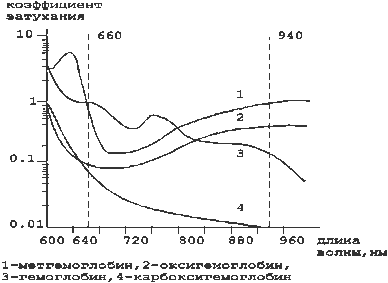
Figure 5 – Dependence of absorption of light on length of a wave of radiation for various forms of hemoglobin
For the purposes clinical oxymetry it is possible to assume, that concentration of fractionsСОНb и МеtНb is small in comparison with concentration НbО2 и Нb, then functional arterial blood saturation can define by means of measurements only on two lengths of waves of light.
For definition fractional saturation it is necessary to use four lengths of waves of radiation in addition to find concentration МеtНb и СОНb.
Advantage of the given method is that speed to take results is provided, sufficient accuracy of measurement. But lack consists that at coeficient definition of absorption it is necessary to consider thickness of blood or preliminary to plant with its plasma. To exclude these lacks, it was offered to define not factor of absorption, and factor of reflection.
The list of unresolved problems
The basic lacks of methods of definition of a blood saturation are the following:
- The majority of devices are installations of laboratory type, their application is possible only on a laboratory;
- Impossibility of the operative control;
- Low periodicity of measurements, time delays in measurements;
- Potentialmetrical methods have low speed and complexity of electronic structures;
- In a technique of pulse oxymetry it is impossible to synchronize precisely the moment of a maximum of a wave and a light a source, phase delay is observed;
- In photometric methods the factor of absorption which directly depends from оптиче ской density of blood in this connection blood in addition plant with plasma that reduces accuracy is defined is certain ия oxygen by laboratory methods.
Thus, the following concern to unresolved problems:
- Efficiency of the control
- Use not laboratory methods without selection of blood
- Elimination of the human factor
- Increase of periodicity of measurements and speed of the device
- Reduction of an error of measurements
Planned and received own result
The purpose of development - creation of the device of definition of oxygen in blood a photometric method. As blood dense enough substance at passage of light through test of blood the significant part light on a current is reflected. Therefore it is more expedient to define factor of reflection, instead of factor of absorption. Hemoglobin has various character of change of factor of reflection and depend from a degree of a saturation oxygen for light waves of various length.
For length of the wave which are being a range 620 … 650 nanometer, dependence is strong, and for length of a wave 650 … 900 nanometers - weak. Owing to that the gauge works on a principle of distinction coeficient of reflections for various lengths of waves and besides such influencing factors as a bodies persons temperature, the exact measurement of a saturation of blood by oxygen is provided are considered.
Data are transferred in computer for the subsequent display, processing and keeping, and process of definition blood oxygen is automated and centralized.
The device is realized in the form of remote optical unit and the electronic block which contains two sources of radiation, optical system and one photodetector. New construction decisions provide increase of accuracy of the device and raise its speed.

The conclusion
As a result of development of the device, use of new circuit decisions it was possible to raise accuracy and speed of the device.
On the basis of results of the lead imitating modelling we can to judge an error of measurement which will make, by our estimations, 3 - 5 %, and time of resultate reception - 2 sec that is a good parameter for devices of the given class.
During performance of work directions of the further researches are planned: development of basic schemes, specification of calculations of power transformations of a signal in optical system, development of the software, a choice of the microcomputer for maintenance of work of measuring system in a mode of real time, and also integration of the developed device in a complex of the electronic equipment modern operational.
The list of sources
-
Хламов М.Г., доц. Применение имитационного моделирования в дисциплине "Электронные системы" кафедра "Электронная техника"
-
Диагностические показатели газообмена и газов крови
-
Булатов М.И., Калинкин И.П. . Практическое руководство по фотометрическим методам анализа -5-е изд., перераб.- Л.:Химия, 1986. - 432 с. Устранение влияния мешающих веществ специальными приемами фотометрических измерений
-
Носов Ю.Р. Оптоэлектроника. - М.: Радио и связь, 1989.- 360 с. Распространение волны излучения в реальной среде
-
К.Ю. ЗюСоЧун Влияние различных факторов на кислородный баланс организма пациента во время операции. www.rusanesth.com/Genan/St_11_6.htm
-
Д-р. Роб Лоу, Королевская больница, Бристоль, Великобритания
Д-р. Х. Буквирва, больница Мулаго, Кампала, Уганда. Физиология транспорта кислорода.
www.ua.arh.ru/06/06_05.htm
-
С.Дж.Фернлей, Отделение анестезиологии больницы Торбэй,
Торквей, Великобритания.
Пульсoксиметрия.
www.ua.arh.ru/05/05_03.htm
-
Заказнов Н.П. Прикладная геометрическая оптика.– М.: Машиностроение, 1984.– 184 с.
-
Креопалова Г.В., Лазарева Н.Л., Пуряев Д.Т. Оптические измерения: Учебник для вузов по специальностям “Оптико-электронные приборы” и “Технология оптического приборостроения” / Под общ. ред. Д.Т. Пуряева. – М.: Машиностроение, 1987. – 264 с.
-
ПрIRладная оптIRа: Учебник для оптических специальностей вузов. / М.И. Апенко, А.С. Дубовин, Г.В. Дурейко и др.; Под общ. ред. А.С. Дубовина, – 2-е изд., перераб. и доп. – М.: Машиностроение, 1992. – 480 с.
-
Скоков И.В. Расчет спектральных интерференционных приборов. – М.: Машиностроение, 1983. – 79 с., ил. – (Б-ка приборостроителя).
-
Имитационное моделирование в задачах оптического дистанционного зондирования / Креков Г.М., Орлов В.М., Белов В.В. и др. – Новосибирск : Наука, Сиб. отд-ние, 1988. – 165 с.
-
Гребнев А.К., Гридин В.Н., Дмитриев В.П. Оптоэлектронные элементы и устройства / А.К Гребнев, В.Н. Гридин, В.П. Дмитриев; Под ред Ю.В. Гуляева. – М.: Радио и связь, 1998. – 336 с.
-
Климков Ю.М. Основы расчета опто-электронных приборов с лазерами. – М.: Сов. радио, 1978. – 264 с.
-
Сорокин В.Г., Авдеев В.Г., Руденко К.Н., Якушина З.К. Определение параметров адаптации, автоматизированных систем контроля поверхностных вод. // Гидрохимические материалы.- 1983.-т.84.-С. 43-50
-
СкрипнIR Ю.О., Присенко М.О., Хімічева Г.І. Автоматичні тепрморезистивні перетворювачі фізичних величин .Київ: ІСДО, 1994. - 132 с.
-
Методы цифрового моделирования и идентификации стационарных случайных процессов в информационно-измерительных системах / А.Н. Лебедев, Д.Д. Недосекин, Г.А. Стеклова, Е.А. Чернявский. - Л.: Энергоатомиздат.Ленинградское отделение, 1988.- 64 с.
-
Пейсахсон И.В. Оптика спектральных приборов. - Л.: Машиностроение, 1975. - 312 с.
-
Проектирование спектральной аппаратуры / Под ред. К.И. Тарасова - Л.: Машинострое-ние, 1980. - 214 с.
|